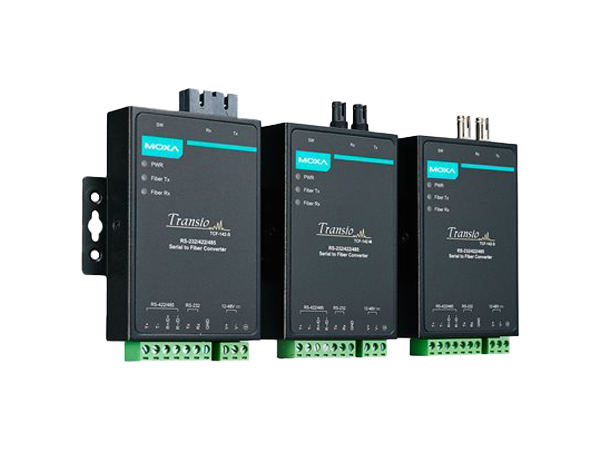Production information
The TCF-142 media converters are equipped with a multiple interface circuit that can handle RS-232 or RS-422/485 serial interfaces and multi-mode or single-mode fiber. TCF-142 converters are used to extend serial transmission up to 5 km (TCF-142-M with multi-mode fiber) or up to 40 km (TCF-142-S with single-mode fiber). The TCF-142 converters can be configured to convert either RS-232 signals, or RS-422/485 signals, but not both at the same time.
Automatic Baudrate Detection
The TCF-142 converters can automatically detect the serial baudrate, which is an extremely convenient feature. Even if a device’s baudrate is changed, the signal will still be transmitted through the media converter without any data loss.
Ring Operation
The TCF-142 converters can be used to connect serial devices to a fiber ring. To form the ring, connect the Tx port of one TCF-142 to the Rx port of a neighboring converter. Once the ring is set up, simply use the DIP switches to configure the TCF-142 converters for ring mode. When one node transmits a signal, the signal travels around the ring until it returns back to the transmitting unit, which then blocks the signal. With the TCF-142, you can set up fiber rings that have a total circumference of up to 100 km.
Automatic Data Direction Control
Automatic Data Direction Control (ADDC) is a hardware data flow solution developed by Moxa to handle RS-485 data direction control. ADDC senses and controls RS-485 data direction automatically, making it unnecessary to use the handshaking signal.
Automatic Baudrate Detection
The TCF-142 converters can automatically detect the serial baudrate, which is an extremely convenient feature. Even if a device’s baudrate is changed, the signal will still be transmitted through the media converter without any data loss.
Ring Operation
The TCF-142 converters can be used to connect serial devices to a fiber ring. To form the ring, connect the Tx port of one TCF-142 to the Rx port of a neighboring converter. Once the ring is set up, simply use the DIP switches to configure the TCF-142 converters for ring mode. When one node transmits a signal, the signal travels around the ring until it returns back to the transmitting unit, which then blocks the signal. With the TCF-142, you can set up fiber rings that have a total circumference of up to 100 km.
Automatic Data Direction Control
Automatic Data Direction Control (ADDC) is a hardware data flow solution developed by Moxa to handle RS-485 data direction control. ADDC senses and controls RS-485 data direction automatically, making it unnecessary to use the handshaking signal.



 采用全球最先进SSL 256bit传输加密机制建议使用Chrome、Firefox、Safari最新版本浏览Design by WebTech 网页设计
采用全球最先进SSL 256bit传输加密机制建议使用Chrome、Firefox、Safari最新版本浏览Design by WebTech 网页设计
